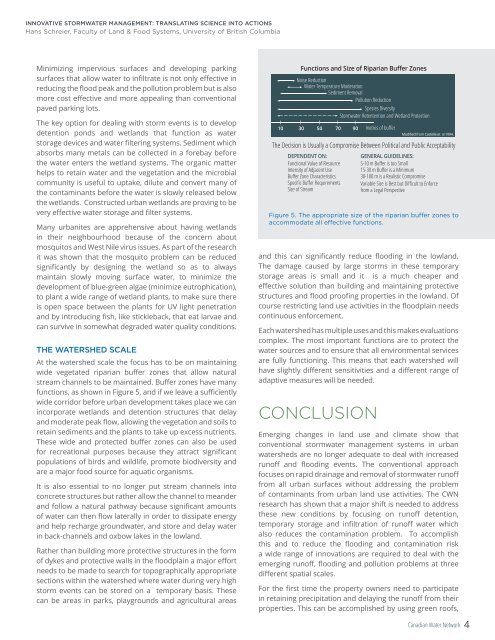CWN-EN-Stormwater-Report-FINAL
CWN-EN-Stormwater-Report-FINAL
CWN-EN-Stormwater-Report-FINAL
Create successful ePaper yourself
Turn your PDF publications into a flip-book with our unique Google optimized e-Paper software.
INNOVATIVE STORMWATER MANAGEM<strong>EN</strong>T: TRANSLATING SCI<strong>EN</strong>CE INTO ACTIONSHans Schreier, Faculty of Land & Food Systems, University of British ColumbiaMinimizing impervious surfaces and developing parkingsurfaces that allow water to infiltrate is not only effective inreducing the flood peak and the pollution problem but is alsomore cost effective and more appealing than conventionalpaved parking lots.The key option for dealing with storm events is to developdetention ponds and wetlands that function as waterstorage devices and water filtering systems. Sediment whichabsorbs many metals can be collected in a forebay beforethe water enters the wetland systems. The organic matterhelps to retain water and the vegetation and the microbialcommunity is useful to uptake, dilute and convert many ofthe contaminants before the water is slowly released belowthe wetlands. Constructed urban wetlands are proving to bevery effective water storage and filter systems.Many urbanites are apprehensive about having wetlandsin their neighbourhood because of the concern aboutmosquitos and West Nile virus issues. As part of the researchit was shown that the mosquito problem can be reducedsignificantly by designing the wetland so as to alwaysmaintain slowly moving surface water, to minimize thedevelopment of blue-green algae (minimize eutrophication),to plant a wide range of wetland plants, to make sure thereis open space between the plants for UV light penetrationand by introducing fish, like stickleback, that eat larvae andcan survive in somewhat degraded water quality conditions.THE WATERSHED SCALEAt the watershed scale the focus has to be on maintainingwide vegetated riparian buffer zones that allow naturalstream channels to be maintained. Buffer zones have manyfunctions, as shown in Figure 5, and if we leave a sufficientlywide corridor before urban development takes place we canincorporate wetlands and detention structures that delayand moderate peak flow, allowing the vegetation and soils toretain sediments and the plants to take up excess nutrients.These wide and protected buffer zones can also be usedfor recreational purposes because they attract significantpopulations of birds and wildlife, promote biodiversity andare a major food source for aquatic organisms.It is also essential to no longer put stream channels intoconcrete structures but rather allow the channel to meanderand follow a natural pathway because significant amountsof water can then flow laterally in order to dissipate energyand help recharge groundwater, and store and delay waterin back-channels and oxbow lakes in the lowland.Rather than building more protective structures in the formof dykes and protective walls in the floodplain a major effortneeds to be made to search for topographically appropriatesections within the watershed where water during very highstorm events can be stored on a temporary basis. Thesecan be areas in parks, playgrounds and agricultural areasFunctions and Size of Riparian Buffer ZonesNoise ReductionWater Temperature ModerationSediment RemovalPollution ReductionSpecies Diversity<strong>Stormwater</strong> Retentention and Wetland Protection10 30 50 70 90The Decision is Usually a Compromise Between Political and Public AcceptabilityDEP<strong>EN</strong>D<strong>EN</strong>T ON:Functional Value of ResourceIntensity of Adjacent UseBuffer Zone CharacteristicsSpecific Buffer RequirementsSize of Streammetres of bufferModified from Castelle et al 1994.G<strong>EN</strong>ERAL GUIDELINES:5-10 m Buffer is too Small15-30 m Buffer is a Minimum30-100 m is a Realistic CompromiseVariable Size is Best but Difficult to Enforcefrom a Legal PerspectiveFigure 5. The appropriate size of the riparian buffer zones toaccommodate all effective functions.and this can significantly reduce flooding in the lowland.The damage caused by large storms in these temporarystorage areas is small and it is a much cheaper andeffective solution than building and maintaining protectivestructures and flood proofing properties in the lowland. Ofcourse restricting land use activities in the floodplain needscontinuous enforcement.Each watershed has multiple uses and this makes evaluationscomplex. The most important functions are to protect thewater sources and to ensure that all environmental servicesare fully functioning. This means that each watershed willhave slightly different sensitivities and a different range ofadaptive measures will be needed.CONCLUSIONEmerging changes in land use and climate show thatconventional stormwater management systems in urbanwatersheds are no longer adequate to deal with increasedrunoff and flooding events. The conventional approachfocuses on rapid drainage and removal of stormwater runofffrom all urban surfaces without addressing the problemof contaminants from urban land use activities. The <strong>CWN</strong>research has shown that a major shift is needed to addressthese new conditions by focusing on runoff detention,temporary storage and infiltration of runoff water whichalso reduces the contamination problem. To accomplishthis and to reduce the flooding and contamination riska wide range of innovations are required to deal with theemerging runoff, flooding and pollution problems at threedifferent spatial scales.For the first time the property owners need to participatein retaining precipitation and delaying the runoff from theirproperties. This can be accomplished by using green roofs,Canadian Water Network 4


